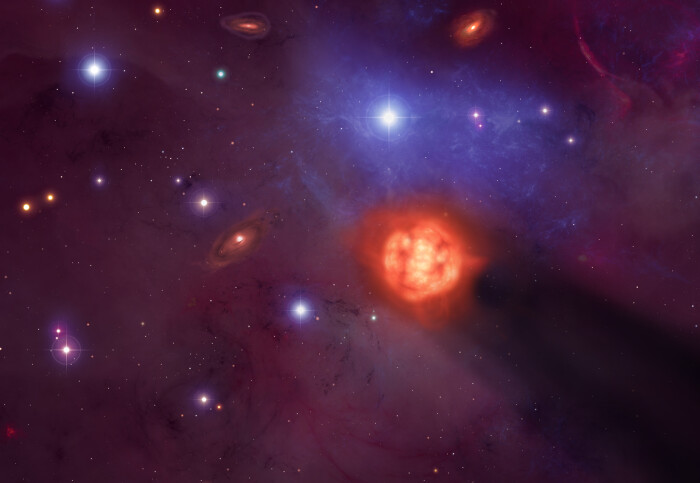Retired stars still have a role to play in planet formation

Credit: Mark Garlick
Old stars roaming through new star-forming regions could be responsible for a radioactive heat source thought to be important for young planets.
The discovery of an older star travelling through a star-forming region shows how these kinds of stars could provide essential radioactive elements to developing solar systems. These elements are needed to provide heat to the interiors of infant planets.
For the Earth, this heat may even have indirectly contributed to plate tectonics on our planet, which helps sustain a breathable atmosphere.
The study, by University of Sheffield and Imperial College London scientists, is published today in the journal Astrophysics Journal Letters.
Heat source
Old, evolved stars called Asymptotic Giant Branch (AGB) stars, shed large quantities of radioactive chemical elements, in particular Aluminium-26 and Iron-60. These elements are known to be a heat source in the early Solar System, when the Earth was forming.
This discovery of an old, evolved star in close proximity to young planet-forming stars is a wonderful example of the power of serendipity in scientific research. Dr Christina Schoettler
As it was believed AGB stars didn't have close encounters with young stars, the source of these elements was thought to be very massive stars that formed nearby. However, the radiation from these stars is thought to be so intense that it could actually stop planets from forming, creating a conundrum.
The new study reports the observation of an AGB star moving through a young star-forming region, presenting a potentially more viable way of providing these radioactive elements.
Lead author Dr Richard Parker, from the University of Sheffield, said: “AGB stars have been known to be a viable source of Aluminium-26 and Iron-60, but until now researchers have been sceptical that these old, evolved stars could ever meet young stars that are forming planets.
“By showing that AGB stars can meet young planetary systems, we have shown that other sources of Aluminium-26 and Iron-60, such as the winds and supernovae of very massive stars, may not be required to explain the origin of these chemical elements in our Solar System.”
Serendipity in science
The team discovered the AGB star using the Gaia satellite, a €740m European Space Agency mission to map the positions of billions of stars in our galaxy. The most recent release of data from Gaia, Data Release 3, allowed the researchers to accurately pinpoint interloping stars – stars that did not form in the region, but are passing through.
The star was found in star-forming region NGC2264 – containing the Cone Nebula and the Christmas Tree Cluster – which is located about 2,500 light-years away.
In addition to discovering this AGB star, the researchers calculated how much Aluminium-26 and Iron-60 from the AGB could be captured by a star like our Sun as it formed its planets.
Dr Christina Schoettler from the Department of Physics at Imperial College London, who identified the AGB star in the Gaia DR3 data, said: “Gaia is revolutionising our ideas about how stars form, and then subsequently move in the galaxy. This discovery of an old, evolved star in close proximity to young planet-forming stars is a wonderful example of the power of serendipity in scientific research.”
-
Based on a press release by the University of Sheffield.
‘Isotopic enrichment of planetary systems from Asymptotic Giant Branch stars’ by Richard J. Parker and Christina Schoettler is published in Astrophysics Journal Letters.
Article supporters
Article text (excluding photos or graphics) © Imperial College London.
Photos and graphics subject to third party copyright used with permission or © Imperial College London.
Reporter
Hayley Dunning
Communications Division